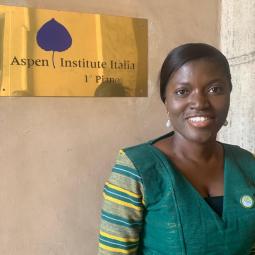OWSD Nigeria National Chapter Presents "EARLY INTRODUCTION OF CODING AND ROBOTICS IS KEY TO ELICITING GIRL-CHILD INTEREST IN TECH-FIELDS "
April 04, 2021
OWSD Nigeria National Chapter University of Port Harcourt Branch Series of Scientific Communications:Nkolika O.Nwazor on EARLY INTRODUCTION OF CODING AND ROBOTICS TO GIRL-CHILD
EARLY INTRODUCTION OF CODING AND ROBOTICS IS KEY TO ELICITING GIRL-CHILD INTEREST IN TECH-FIELDS
Nkolika O. Nwazor (Ph.D)
Electrical/Electronic Engineering Department, University of Port Harcourt
-
Introduction
Coding and robotics are two of the most exciting and most important areas of contemporary STEM education, helping to create all kinds of beneficial, hands-on learning for students (Eduporium,2021). Teachers can use these tools to teach programming, computational thinking, creative problem solving, hardware, and a whole lot more (Eduporium,2021). The Beijing declaration in 1995 which demonstrated strong support for the empowerment of girls and women and their inclusion in all spheres of the society to date is the most comprehensive agenda for the female gender. The recent improvements in technologies have placed demand for better skilled and educated individuals especially in science, technology, engineering and mathematics (STEM) fields (Alam, 2020) especially the technical fields like computer science and engineering. These technological advances notwithstanding, there is still a wide gap between the male and female gender in terms of their participation in these fields. As the world responds to the challenges posed by climate changes, epidemics and pandemics, there is great need for STEM skills and knowledge in tackling these crises. There is need to explore the contributions of women in proffering solutions to these life-threatening challenges considering their God-give qualities of resilience and their multi-tasking and other innate capabilities.
Traditionally, the STEM subjects/fields especially the technical fields are seen as tasking and difficult subjects/fields naturally designed for male gender. The girl-child is trained directly and indirectly to see herself inferior to the male counterpart in terms of strength and therefore not cut out for STEM subject. The teachers also contribute their quota by misrepresenting STEM subjects/fields as fields cut out for the masculine gender. Thus, gender norms and gender stereotypes discourage girls from participating in STEM. They grow up believing that roles that involve the use of physical strength are meant for boys and if they get involved in such, they are no more feminine. Limited exposure to female STEM role models and the use of masculine characters in STEM advertorials and pictures on textbooks also poses as limiting factors.
Currently the participation of the female gender in the workforce especially in the fourth industrial revolution is quite low. This can be attributed to the fact that most of them are not fully equipped with the right technical skills because the mindset generally and most especially in Africa is that it is men’s field. The goal of this paper is to demonstrate the impact of early introduction of coding and robotics in girl-child education on their interest in technical fields like computing and engineering, thereby closing the gender gap. It also explains how o spark the interest of the girl-child in these tech-fields and the role women have to play.
-
Coding and Robotics
Coding or Programming is the foundation of robotics, video games, apps, computer graphics, and much more. A program is a set of instructions; a sequence of short commands. Programming is used as the tool to write and disseminate those individual instructions (Ryan, 2019). A programming language, then is made up of its own vocabulary and set of rules with each language having its own unique syntax (grammatical structure) and semantics (meaning) (Ryan, 2019). The introduction of programming to children and youths has a lot of advantage, it helps them think and solve problems in an organized way. (Heininger et al., 2017).
Robotics is a STEM that includes constructing, operating, designing, developing and applying codes that will make a robot work. In simple language, it is a method of gaining control over machines. Robotics integrates fields of mechanical engineering, electrical engineering, information engineering, mechatronics, electronics, bioengineering, computer engineering, control engineering, software engineering, among others (Wikipaedia,2021). It develops machines that can substitute for humans and replicate human actions. Robots can be used in many situations and for many purposes, but today many are used in dangerous environments (including inspection of radioactive materials, bomb detection and deactivation), manufacturing processes, or where humans cannot survive (e.g. in space, underwater, in high heat, and clean up and containment of hazardous materials and radiation).
It is a rapidly expanding field that stores many career scopes in the future. Robotics courses for kids are a great idea for those parents who want to make their kid future-ready. One of the most innovative technological concepts currently available is the idea of using robots for teaching children (Dimick, 2016). Robotics is a fascinating field that can benefit students from elementary school all the way up to graduate courses. Educational robots have up-to-date computing power, innovative engineering, and can be controlled not only via apps but using voice and gestures, as well (Dimick, 2016). The activity of programming a robot and even building one from a kit is an ideal way to teach technology and engineering skills (Dimick, 2016). It can help children naturally learn and adapt to the useful principle of computational thinking.
Coding and robotics expose children to the engineering design process which involves problem identification, planning a solution after critical thinking, building and testing their creation, discovering that things don’t always work as planned (thus, they learn how to continually make improvements) and in the process of trying to improve on what they have the seek input from others thereby learning the art of collaboration to (Kinderlab, 2018).
2.1 Early childhood Introduction to Coding
It is worthy of note that there are several factors that can generally affect people’s interest in computing. Some of these factors may be external or internal and include age, teaching methods, course structure, environment, culture, instructor, type of evaluation and previous knowledge (Kim, 2020). According to Sullivan et al (2015), there is need to arouse the interest of young girls in computing at early adolescence because that is the period that their interest begins to wane due to negative stereotypes about technology fields in comparison to boys. It was observed that girls show less interest in computer, spatial and science-related games and technological toys than boys and do not see computers as creative tools (Cheryan et al, 2015; Sullivan et al, 2003). Research have shown that computer games are effective tools for improving children’s confidence in the use of computer but the major challenge is that most of them are developed for, purchased by and used by boys and men almost (Barker &Aspray, 2006).
Technology is improving at a very rapid rate and these days children are more familiar with technological tools and are becoming more confident in their use. According to Papavlasopoulou et al (2019) children learn more easily when they are required to make meaningful creations. Horn et al (2009) also posited that tangible interactions can help children become more actively involved and self-motivated. The introduction of interactive graphical user interfaces and virtual world in the teaching of STEM has positively impacted the outcome.
According to (Kinderlab, 2018) the 6 benefits of coding are:
- Coding Teaches the Literacy of the 21st Century
- Coding Develops Computational Thinking Skills
- Technology Becomes the Playground
- Robotics Makes Coding Tangible and Concrete… and Screen-Free
- Using technology breaks down engineering stereotypes
- The Engineering Design Process Develops Grit and Perseverance
-
Early childhood Introduction to Robotics
The research by Master et al (2017) showed that children taught using robots as a motivation for STEM had higher technological motivation than others. The study showed that both boys and girls showed equal interest in technology and their own feeling of self-efficacy or confidence in their own abilities. The gender gap according to the authors was reduced to 42% while the gap in self-efficacy was reduced by 80%. Though the stereotypes weren’t affected, the authors recommended the introduction of more programming in school or as after school activities like summer camps and meeting or seeing a woman programming robots or working in a STEM field as a means of shifting the gender STEM stereotypes in STEM (Master et al, 2017). Coding with robots shows children that they can create with technology. At a tender age, children are adventurous, they are curious about the world around them which include the technological world.
Benefits of Robotics (Funtechblog, 2021)
- Robotics can be a fun introduction to programming - It takes the static process of programming code and gives it an immediate, tangible result that you can see and feel.
- Robotics is an excellent skill for future career development - With more and more companies switching over to IT-based systems, and with services becoming increasingly complex and customized to meet the unique needs of countless industries, the demand for these skills is only increasing.
- Robotics teaches problem-solving skills - to succeed in robotics takes patience; the courage to work through mistakes; and problem-solving skills.
- Robotics encourages curiosity and creativity - robotics gives your child a toolkit and challenges them to build something new. It will give them the perfect environment to stretch their creative muscles, especially if they are already inclined to building things or show a great deal of curiosity in how things work.
- Robotics prepares them for a technological future - With how quickly technology is advancing, we can only imagine how our world will look in the next ten or twenty years. In light of this, helping your child to develop confidence and fluency in all types of technology will undoubtedly be a great asset to them as they grow older.
3.0 Teaching Coding and Robotics to children
Children between ages three to four years have a lot of energy and are very confident. Although their level of concentration on a task is low, they are always thrilled by the world around them. At this stage their speech is still developing and they often find it difficult articulating what they are trying to do. They don’t differentiate between fields. They are beginning to understand cause and effects. Hands-on learning is very beneficial at this stage as they provide richer sensory information. For best results, the children can be made to act what they want to do before programming it(primotoys,2017). It is better to allow children to navigate their own way through a task, don’t interfere even when they are missing it. Rather than directing the child, the role of the parent should be that of a facilitator, asking good questions to help the child along (primotoys,2017).
At this stage, their sense of agency also helps develop less inhibited creative thinking, and a willingness to try things out and make mistakes. The younger the age, the more difficult it is for them to abstract. Therefore, it’s unlikely that most very young children will benefit from jumping headfirst into early lessons on Python, JavaScript, Scratch or any other on-screen coding language (primotoys,2017). It is better to start computational thinking (breaking down big, complex problems into smaller ones).
Summarily, the best way to teach children between age 3-5 years coding is to(primotoys,2017):
- Use algorithms - set of rules that define a sequence of operations
- Logical reasoning - way for us to understand and explain why things happen the way they do.
- Tinkering - trying things out and learning by trial and improvement.
- Debugging - process of literally getting rid of the ‘bugs’ (or mistakes) within an algorithm.
Children from 5-6 years learn by(primotoys,2017):
- Abstraction - child can begin to think symbolically, which is essential in order to teach kids to code
- Prediction – child’s ability to look at the piece of physical code, or even hold a series of commands in their head, and have an idea of where the programmable robot (or human) will end up
- Sequencing - expression of the ideas of computational thinking (algorithms, decomposition, logical reasoning), in written form (coding).
- Programming - a program is a collection of sequential instructions. which must be clear and unambiguous otherwise the program won’t work.
- Repetition - execution of an instruction or instructions within a program is repeated
At this stage they learn patience and persistence and are enrolled in formal education Coding can become a playground, an environment to be creative, to express ourselves, to explore alone and with others, to learn new skills, and to problem solve. All of this, while having fun.” (Bers, 2018)
3.1 Tools to Use
Integrating robotics and coding in early childhood can be made easier with the following tools:
- KIBO: it is a block-based coding language that gives children control over the robot’s movements, sounds, and sensors, allowing them to express their imaginations with code. With KIBO, children can tell stories, create characters, and explore their world (Kinderlab,2018). www.kinderlabrobotics.com
- Blue-Bot: Simple robot ideal for introducing programming to young learners. Students will develop logical and sequential thinking with Blue-Bot, creating a foundation for future coding activities. https://www.terrapinlogo.com/blue-bot-family.html
- Blockly for Dash & Dot Robots: Adorable robots teach hands-on coding skills. You can program robots with code blocks, with plenty of creative options and lots of fun. https://play.google.com/store/apps/details?id=com.makewonder.blockly&hl=en&gl=US or https://www.makewonder.com/apps/blockly/
- Robo Code - Modular robot encourages creativity with endless possibilities. It is an interactive, playful way to teach coding and build problem-solving skills in young learners. https://robocode.sourceforge.io/
- The Robot Factory by Tinybop - Improve designs, collect favorites in robot creation sandbox. A well-made and enjoyable STEM app that leverages what's great about play -- experimentation -- to spark engineering interest. https://tinybop.com/apps/the-robot-factory
- Gizmos & Gadgets - Top-notch tool empowers kids to invent, build, and control wirelessly. Easy-to-use, versatile electronic invention set that works wirelessly with your hand-held device. https://gizmosandgadgetsgy.com/
- SAM Labs - Kids use block code and wireless blocks to program, design, and create. With some perseverance, it's a great fit for PBL and STEAM, helping students learn programming skills and engineering concepts through invention. https://samlabs.com/us/
- Virtual Robotics Toolkit - Supplement your Lego robotics program with solid simulator. Virtual Robotics Toolkit can up your game by providing useful data as you test code and explore challenges virtually. https://www.virtualroboticstoolkit.com/
- Root - a robot with the aim of helping children learn how to code. Designed for kids at different school levels, it includes over 50 sensors and actuator motors. https://edu.irobot.com/what-we-offer/root-robot
Programming Languages for children
- Scratch - MIT-developed graphical programming language, based on drag-and-drop programming basics so children can easily create interactive stories, comics, and more. It makes use of coding blocks and cartoon sprites instead of lines of code. https://scratch.mit.edu/
- Lua - great for students interested in applying their newfound coding skills to game programming. http://www.lua.org/
- Minecraft - There's a good chance your kid already plays this blocky pixelated game on her phone, computer or tablet. https://www.minecraft.net/
- Codemonkey - user-friendly and intuitive. CodeMonkey takes a straight-forward approach, teaching real text-based code in a manner that even 8-year-olds can understand. https://www.codemonkey.com/
- Gamestar Mechanic - teaches kids, ages 7-14, to design their own video games. Your students will love completing different self-paced quests while learning to build game levels. https://gamestarmechanic.com/
- Tynker - The interface looks similar to Scratch. But while Scratch was designed to program, Tynker was built to teach programming. The app features starter lesson plans, classroom management tools, and an online showcase of student-created programs. https://www.tynker.com/
- Move the turtle - a gamified way to learn programming procedures. Each new level of achievement increases in difficulty and teaches a new command that directs the turtle to reach a star, make a sound, draw a line, etc. https://movetheturtle.com/
- Hopscotch - looks a lot like Scratch and Tynker and uses similar controls to drag blocks into a workspace, but it only runs on the iPad. It is a great tool to begin helping students without coding experience learn the basics of programming, logical thinking and problem solving. https://www.gethopscotch.com/
- Daisy the Dinosaur - Daisy targets the youngest coders. The interface is similar to Hopscotch but much simpler. There is only a dinosaur to move and only basic functions to use, but for your younger students, this is an excellent introduction to programming. https://apps.apple.com/us/app/daisy-the-dinosaur/id490514278
- Cargo-Bot - On each level, the objective is to move colored crates from one place to another by programming a claw crane to move left or right, and drop or pick up. https://altermanchess.wixsite.com/cargobot
- Code.org - Addictive games and lessons that make students motivated to learn coding. https://code.org/educate/applab
- Appinventor.org - Great website that gives teachers the resources that they need to teach coding. The end result is students making their own apps. http://www.appinventor.org/
- Codecademy - This site teaches kids how to code with a hands-on approach. Very popular among educators. https://www.codecademy.com/
- Khan Academy - https://learn.khanacademy.org/khan-academy-kids/
- codeSpark Academy - https://codespark.com/
The list is not exhaustive. You can check the following web pages for more coding and robotic applications for children:
https://teachyourkidscode.com/best-coding-apps-for-kids/
https://codewizardshq.com/coding-for-kids-free/
https://codewizardshq.com/coding-websites-for-kids/
https://www.robowunderkind.com/
4.0 Gender-Responsive STEM Education
This involves application-based teaching of science, mathematics, technology and engineering (STEM)in such a way that gender inequality is erased or greatly reduced thereby improving gender equitable use of digital technologies (Alam, 2020). This will help improve the participation of girls and women in STEM and also in their understanding of the issues in the world around them and encourage them to actively participate in constructive arguments that will lead to relevant solutions with their male counterparts (Alam, 2020). It will position them for gainful employment especially in this era of industry 4.0 and help increase their literacy and numeracy. This form of education will stir up the innovative and entrepreneurial spirit in them. A good example is the Afghan Girls’ robotic team that invented two models of ventilator in response to their governor’s call for ventilators to help covid-19 patients (Alam, 2020). The population of women globally is greater than that of the male, therefore failure to invest in their tech-education will deny the world a greater percentage of the solutions that can be derived from STEM. The introduction of gender responsive pedagogy in STEM education will help increase girls’ interest in these fields.
Other means of increasing the interest of girls in STEM include: the use of gender responsive career counselling; portraying positive images of women in STEM to the children at early childhood stage; revising STEM curriculum to remove any gender bias, employing more female teachers for STEM; the use of financial incentives like scholarships and use of digital teaching aids like augmented and virtual reality. Girls should be made to understand that intelligence is not fixed but can be improved through training and hard work. This can help them persist through challenges. Adding images of female mathematicians or scientists throughout classroom materials and assigning individual or group work that summarizes or contextualizes women’s achievements in these subjects can also shift perceptions about who belongs. Teachers, especially female teachers should as much as possible avoid the use of negative words like “ I hate mathematics” or “ Mathematics is difficult” in class.
5.0 Conclusion
Coding and robotics have been proven over time to be veritable tools in increasing children’s interest in STEM. Early introduction of these STEM tool to young girls is key to closing the gender gap in children’s interest in technical fields like computer science and engineering before they form stereotypes that make them believe that the STEM fields are for the male gender. Parents, teachers, application developers, government, women in STEM and the children themselves have their roles to play in breaking this gender barrier. Women scientists have a great role to play in encouraging the younger generations to develop interest in the STEM fields. The teachers among them should be good role models both in their teaching and practice of the profession. The development of robots and applications that have feminine characters is encouraged as a way of wiping out already formed negative stereotypes. The older generation of females in stem fields are also encouraged to visit these young ones in their school especially on career days and also mentor them. Scholarships and extra-curricular activities aimed at motivating these young girls are also encouraged.
References
Andaleeb Alam (2020), Towards an equal future: Reimagining girls’ education through STEM. https://www.unicef.org/media/84046/file/Reimagining-girls-education-through-stem-2020.pdf
Barker, L. J., & Aspray, W. (2006). The State of Research on Girls and IT. Women and Information Technology, 2-54. doi:10.7551/mitpress/9780262033459.003.0001
Primotoys (2017). Beginning computer programming for kids: An introductory guide to computational thinking and coding for kids aged 3-6 years old. https://www.primotoys.com/wp-content/uploads/2017/09/Ebook-PrimoToys_final-1.pdf
Bers, M.U., (2018). Coding as a playground: Programming and computational thinking in the early childhood classroom. New York, NY: Routledge press.
Carly Berwick( 2019). Keeping Girls in STEM: 3 Barriers, 3 Solutions https://www.edutopia.org/article/keeping-girls-stem-3-barriers-3-solutions
Cheryan, S., Master, A., & Meltzoff, A. (2015). Cultural stereotypes as gatekeepers: Increasing girls, https://www.frontiersin.org/articles/10.3389/fpsyg.2015.00049/full
Commonsense Educational (2021), Best Robotics Apps and Websites for STEM Classrooms.https://www.commonsense.org/education/top-picks/best-robotics-apps-and-websites-for-stem-classrooms
Eduporium (2021). Robotics Tools for Teaching Different Coding Languages. https://www.eduporium.com/blog/eduporium-weekly-robotics-tools-for-teaching-different-coding-languages/
Funtechblog (2021), 5 Reasons Why Kids Should Know Robotics. https://funtech.co.uk/latest/5-reasons-why-kids-should-know-robotics
Harang Kim (2020). Designing Learning Activities to Support Young Women’s Interest in Programming and Computational Thinking. A Masters’ dissertation submitted to the university of Malmo.
http://www.diva-portal.org/smash/get/diva2:1480590/FULLTEXT01.pdf
Heininger, R., Prifti, L., Seifert, V., Utesch, M., & Krcmar, H. (2017). Teaching how to program with a playful approach: A review of success factors. IEEE Global Engineering Education Conference (EDUCON). doi: 10.1109/educon.2017.7942846
Horn, M. S., Solovey, E. T., Crouser, R. J., & Jacob, R. J. (2009). Comparing the use of tangible and graphical programming languages for informal science education. Proceedings of the 27th International Conference on Human Factors in Computing Systems – CHI 09. doi: 10.1145/1518701.1518851
KinderLab Robotics (2018), Inc, 6 key benefits of using robotics in your early childhood classroom
https://edcuration.com/resource/vendor/103/KinderLab%206-Key-Benefits-of...
Master, A., Cheryan, S., Moscatelli, A., & Meltzoff, A. N. (2017). Programming experience promotes higher STEM motivation among first-grade girls. Journal of Experimental Child Psychology, 160, 92–106. doi: 10.1016/j.jecp.2017.03.013
Papavlasopoulou, S., Giannakos, M. N., & Jaccheri, L. (2019). Exploring children’s learning experience in constructionism-based coding activities through design-based research. Computers in Human Behavior, 99, 415–427. doi: 10.1016/j.chb.2019.01.008
Patricia Dimick (2016). 5 Educational Robots You Can Use in Your STEM Classroom. https://www.emergingedtech.com/2016/11/5-educational-robots-for-stem-steam-classroom/
Ryan (2019), Coding for kids: Reasons kids should start coding & how they can find success https://www.idtech.com/blog/5-reasons-your-child-should-learn-to-code
Wikipaedia (2021). Robotics. https://en.wikipedia.org/wiki/Robotics











































